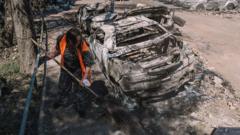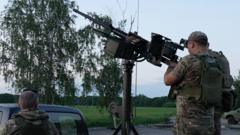As fears of Russian aggression loom, nations in Eastern Europe explore measures to fortify their borders, sparking outrage among anti-mine advocates.
**European Nations Consider Reinstating Land Mines Amid Rising Security Concerns**

**European Nations Consider Reinstating Land Mines Amid Rising Security Concerns**
Amid increased tensions with Russia, five countries are contemplating a return to land mine usage, defying a long-standing international treaty.
In response to escalating security threats and ongoing hostilities following Russia's invasion of Ukraine, five Eastern European nations are signaling a potential return to the use of landmines, a method of warfare long banned by international treaty. Poland, the three Baltic states, and Finland are considering revoking their adherence to the 1999 Mine Ban Treaty, a move that has drawn fierce criticism from anti-mine advocacy groups.
Historically, antipersonnel mines were utilized to secure borders during the Cold War, separating the Soviet bloc from Western nations. After the Cold War's conclusion, there was a concerted global effort, influenced significantly by activists like Diana, Princess of Wales, to eliminate these deadly devices from the battlefield. The resultant international push culminated in the establishment of the Ottawa Convention in 1997, banning the production and deployment of landmines due to their indiscriminatory nature and tragic impact on civilian lives.
Currently, the push by Poland, Estonia, Latvia, Lithuania, and Finland reflects a desperate attempt to bolster national security in the face of perceived aggression from Russia. President Volodymyr Zelensky of Ukraine has also echoed similar sentiments, suggesting that nations must do all they can to protect their borders. Nonetheless, formal withdrawal from the treaty is a lengthy process involving a six-month timeline, meaning that any immediate implementation of landmines is unlikely.
The proposal has incited outrage among those advocating for the continued ban on landmines, including Tamar Gabelnick, director of the International Campaign to Ban Landmines. She expressed her dismay, emphasizing the ramifications of such a decision, which threatens to undo years of progress toward eradicating these weapons designed to maim and kill indiscriminately.
As these discussions unfold, the world watches closely, weighing the complex balance between national security and humanitarian considerations in a rapidly evolving geopolitical landscape.
Historically, antipersonnel mines were utilized to secure borders during the Cold War, separating the Soviet bloc from Western nations. After the Cold War's conclusion, there was a concerted global effort, influenced significantly by activists like Diana, Princess of Wales, to eliminate these deadly devices from the battlefield. The resultant international push culminated in the establishment of the Ottawa Convention in 1997, banning the production and deployment of landmines due to their indiscriminatory nature and tragic impact on civilian lives.
Currently, the push by Poland, Estonia, Latvia, Lithuania, and Finland reflects a desperate attempt to bolster national security in the face of perceived aggression from Russia. President Volodymyr Zelensky of Ukraine has also echoed similar sentiments, suggesting that nations must do all they can to protect their borders. Nonetheless, formal withdrawal from the treaty is a lengthy process involving a six-month timeline, meaning that any immediate implementation of landmines is unlikely.
The proposal has incited outrage among those advocating for the continued ban on landmines, including Tamar Gabelnick, director of the International Campaign to Ban Landmines. She expressed her dismay, emphasizing the ramifications of such a decision, which threatens to undo years of progress toward eradicating these weapons designed to maim and kill indiscriminately.
As these discussions unfold, the world watches closely, weighing the complex balance between national security and humanitarian considerations in a rapidly evolving geopolitical landscape.





















